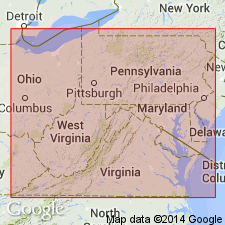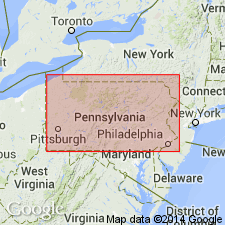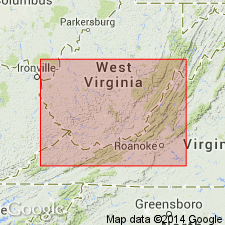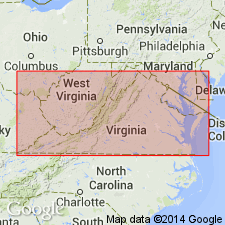
- Usage in publication:
-
- Minnehaha Springs Member
- Modifications:
-
- Named
- Dominant lithology:
-
- Siltstone
- Shale
- AAPG geologic province:
-
- Appalachian basin
Summary:
Minnehaha Springs Member here named for village in Pocahontas Co., WV, and assigned to the Scherr Formation of the Greenland Gap Group. Unit is a "clastic bundle" consisting of interbedded medium gray siltstone and olive gray shale with some grayish-red siltstone and shale, elsewhere some sandstone. Unit identified in outcrop and subsurface for 235 km along Allegheny Front. Deposited by turbidity flows from submarine fans with faunal communities. Possible shoreward equivalent of gas productive Sycamore grit. Overlies Millboro Shale. 6.37 to 30.0 m thick at type. Age is Late Devonian.
Source: GNU records (USGS DDS-6; Reston GNULEX).

- Usage in publication:
-
- Minnehaha Springs Member
- Modifications:
-
- Revised
- AAPG geologic province:
-
- Appalachian basin
Summary:
The Minnehaha Springs Member is recognized in the lower Lock Haven Formation of north-central PA. It is proposed here that the member mark the base of the formation. It is composed of fine- to medium-grained turbidites, deposited in a low angle, slope apron environment.
Source: GNU records (USGS DDS-6; Reston GNULEX).

- Usage in publication:
-
- Minnehaha Springs Member
- Modifications:
-
- Areal extent
- AAPG geologic province:
-
- Appalachian basin
Summary:
Arbitrary stratigraphic cutoffs are drawn where formational diagnostic characteristics are lost by facies change. The Scherr Formation ends at the WV-VA boundary because it becomes finer grained and the last sandstone disappears. It passes laterally into the Brallier Formation. Although the Minnehaha Springs Member turbidite bundle loses its sand southwestward, a siltstone bundle can still be identified as the Minnehaha Springs within the Brallier Formation as far southwest as White Sulphur Springs.
Source: GNU records (USGS DDS-6; Reston GNULEX).

- Usage in publication:
-
- Minnehaha Springs Member
- Modifications:
-
- Revised
- AAPG geologic province:
-
- Appalachian basin
Summary:
Two intervals of coarse siltstones within the Brallier Formation near Salem are believed to represent the Back Creek Siltstone and the Minnehaha Springs Members. The Minnehaha Springs marks the base of the Scherr Formation to the north, and here marks the base of the Scherr-equivalent part of the Brallier. The Back Creek is 9 m thick in the area, while the Minnehaha Springs is 24 m. The Brallier is a total of 518 m.
Source: GNU records (USGS DDS-6; Reston GNULEX).
For more information, please contact Nancy Stamm, Geologic Names Committee Secretary.
Asterisk (*) indicates published by U.S. Geological Survey authors.
"No current usage" (†) implies that a name has been abandoned or has fallen into disuse. Former usage and, if known, replacement name given in parentheses ( ).
Slash (/) indicates name conflicts with nomenclatural guidelines (CSN, 1933; ACSN, 1961, 1970; NACSN, 1983, 2005, 2021). May be explained within brackets ([ ]).

